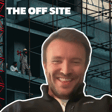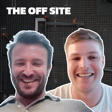Become a Creator today!Start creating today - Share your story with the world!
Start for free
00:00:00
00:00:01

Podcast Ep.30
Transcript
Podcast Rituals and Audio Advice
00:00:00
Speaker
Geez. That last week's one didn't make you look as bad as it actually was. You literally couldn't count to 10. Yeah, that was a struggle. Are you standing up? Yeah. It's my only steps in the day. If I don't stand up for this podcast, I'm doing no steps for the day. My little things beeping at me, stand up, sit down, stand up.
00:00:28
Speaker
Even though you're on a screen, it's like you're looking down at me. It's really like... Yeah. You should see my calendar. It says podcast and exercise at the same time. Your GP must love that. GP? Sorry, your doctor. I thought you said gross profit. Oli, you wanted a popcard, didn't you? Yes, please. I'm just going to go behind you and grunt a little bit.
00:00:57
Speaker
Um, Jason, I don't know if you want to like push your mic slightly further away than when you're talking or something. Olu, do you know what I mean? Like, um, just then it might be my headphones, but just then every now and again, when you were talking, it was like, um, going a bit funny. Yeah. Hopefully the pop guard will deal with that because that's, it's like take out harshness in some of the, some of the plosives. Right. Okay.
00:01:27
Speaker
I'm just going to take my headphones off for a sec because for some reason it's got my legs and walked away. Is that better from a higher? No. That's better isn't it?
Format Changes and Reactions
00:02:17
Speaker
Did Jason mention the change to the podcast? Yep. A bit of a shame, but what can we do? Oli, this control at the front, which is left, mic, right, come, do I need to change it yet or not? Or the volume? What's the setting? It's a dial. Is it selected on anything or is it just like
00:02:46
Speaker
It just looks like it will turn. So in any way for me to know how far left or right it is, is to turn it. That's for the volume, right? Or is that for the one that's called mic calm? And there's another one which is the same for volume. Is this headphone volume? All right. Throw it all the way to. Right. The bomb one. Mike come on. Yeah. That's all the way to the right. Okay. And I thought all the way to the left.
00:03:16
Speaker
That's the way to the left. What's that? Yeah. Yeah. Always doing the Cuban shuffle. Yeah. If you get it back to the right as well, that'd be nice. Um, would you mind, I think the, the volume one is, is basically like, um, live metering volume. So shouldn't do anything. Okay. Um,
00:03:48
Speaker
Yeah, if I remember correctly. It looks like you're about to spit some bars, Jason. It's great fire.
00:04:30
Speaker
Right. How's that? No plosives. Peter, five, a big, two, pepper, pit, a foot pick. I'm as our intro. No, I think the one before about whether I was standing up is better than that. Otherwise I wouldn't embarrass myself like that. I'll make the executive decision. Um, you hold all the power. Yeah, baby.
00:05:01
Speaker
All right, we good? Ready when you are. We're already recording, so. Cool. All right.
Introducing Offsite Podcast and UK Weather
00:05:18
Speaker
Hello and welcome to episode 30 of the Offsite Podcast, where we chat all things construction and technology. My name's Carlos Cavado. And I'm Jason Lanzini. How are you doing today, Carlos?
00:05:30
Speaker
Pretty good, thanks. It's like five degrees in the UK now, so it's cold and horrible and miserable, and you're standing there in the t-shirt, so I'm quite jealous. Yeah, well, I do have an air conditioning going, because it is kind of the opposite. And today, we're going to actually do some of the technology bit of construction and technology. Is that right? We're going to talk about some actual technology. Yeah, yeah, we make a big claim that we talk about both, but I can't remember the last time we did a tech chat.
Project Tools and Tech Predictions
00:06:01
Speaker
So yeah, we'll bring it back strong. Cool, I'm looking forward to it. So on that theme, so today we're going to talk about technology. Now we spend most of our time talking to projects about how they deliver those projects. One of the benefits of that is we get pretty good insight into the sorts of tools they use, they love, they hate, they're mandated, they trial and everything else.
00:06:29
Speaker
So we've got an idea about what is used, what might be popping up. We also like to think that we keep track of the general market anyway. So today we are picking three tools each and sort of pitching the fact that we're going to see maybe more of it next year or they're going to sort of emerge as a key player in their space. You're skirting around it. You did say it was predictions. We had to make a prediction that we would be held against, didn't you?
00:07:01
Speaker
Yeah, I guess I held off the word prediction because one of my three is like, it's already doing pretty well. So I kind of piggyback off. So Jason, you're up first.
Spotlight on Sitemate - No-Code Tool for Construction
00:07:21
Speaker
Okay, right so Well, I I've picked three I've gone heavily on Australian led or base companies so first one I'll
00:07:35
Speaker
talk about is a company that was originally, I think, based out of Sydney. The company is called Sitemate. We might have talked about it before Carlos offline. You can kind of think of it, I think their tagline is something like a no code tool builder specifically for construction, but I guess to translate that, you can think of it kind of like Airtable, but specifically for construction.
00:08:01
Speaker
So there's like a database and you can build tools and applications on top of it. So kind of like an easy to use power apps, maybe another way to think of it, if you're in a Microsoft ecosystem. Is this trying to get rid of like the endless like list of spreadsheet trackers and things like that?
00:08:24
Speaker
Yeah, basically anything that's in a spreadsheet or, you know, I guess you could see a lot of smaller companies that have a lot of stuff living in spreadsheets. They're thinking about moving to a system, but then the leap to like a pro core or something's a lot of money, um, et cetera. So you could see a sort of having a generic.
00:08:47
Speaker
workflow tool builder, fill that gap where you could have a safety documents living, like a safety workflow fill out inspection. So you can create a form piece that people fill in the form, you can have workflows of approvals that sit on top of it. So you end up with like a form builder, and then that's populating a database. Why it could do anything.
00:09:13
Speaker
Is there anything about it that's like construction specific? Because in my mind I'm thinking, why are the generic tools that can do all of these things pretty well, not just used?
Buildots - Progress Tracking in Construction
00:09:22
Speaker
And is it because construction like being pitched something that's for construction or is there like aspects that are pretty like construction specific? There's like a, there'll be a whole marketing story of like the positioning of it. But, and then like, I think they have a lot of built-in templates that are like, here's your site diary template. Here's your,
00:09:40
Speaker
You know, like if you go to like an air table, you're going to get a lot of like, here's how Airbnb do their product development sprint using power apps and things like that. Yeah, it's just an everything. So they have a lot more domain expertise in construction. The founding team are from construction.
00:09:59
Speaker
and they build tools and I think layer on some of the other controls and you know field types and stuff that construction specifically need and they're now pushing towards integration specifically for construction. So you're not standing start when you pick it up like you would with an air table or an ocean. That's what I like about it because I think there's a real clear playbook for them like
00:10:23
Speaker
If you can make it really easy for a company or a project to start building their first tool, whether it's like a site diary or a safety inspection or whatever it is, once some people get the hang of that, then every other form or tool that they build is almost like it's free.
00:10:41
Speaker
because you're paying per user. So you can start to really like stick in a lot of different workflows into this one product. And once you do that, then that customer is super sticky because they've invested so much time building out a set of tools in your product. So I think it's really cool. How early are they?
00:11:01
Speaker
They're not that, well, in the relative to big company, they're early, but they just raised the Series A like, I think weeks ago, as we're talking now, they raised another seven and a half. And they definitely raised like more than five before that. And they've established a North America office. They've got a team now based out of the UK. And I think starting to put some interesting pieces together. So I think it's,
00:11:32
Speaker
Yeah, definitely want to watch. So for me next year, I think like this is a prediction for us. I think we're going to see them turn up on our customers more often. Um, but I think that they will, um, I think that there are smaller companies, like I said, that don't want to make the leap to like a, like a full stack solution that's expensive. And then even in like the bigger contractors that,
00:12:00
Speaker
There's so much baggage in making a decision to move from whatever thing that currently doing that it takes so long. I can see projects adopt just building out what they actually need. Um, yeah, I can imagine it's the same as like Power BI. Uh, people love to customize and every projects, every person, everyone wants their own thing. So it gives them that flexibility to like adopt and then grow.
00:12:28
Speaker
Yeah. Yeah. Makes sense. And every construction software, the problem with it, like the problem with so many of them is that they're like, as we're saying previously, like it's like Bill's way of doing site diaries or Fred's way of doing it from this project.
00:12:44
Speaker
Um, if you build a whole product around that way, it's very niche, but if you can build a tool builder and maybe you have a template that is Bill's way and you have a template that like, then you've suddenly got something that, um, wider groups of people could adopt and stick with. So I think it's really cool. I think they're doing a great job. Yep. So the first pick, what do you got?
00:13:08
Speaker
So my first one is not a small company. I've got one massive one and I've got one really new and niche one so I thought they balanced quite well but the first one
00:13:29
Speaker
They've raised nearly 100 million, I think, something like that, but build dots. And the reason I've picked them is in the last three months, I've heard them mentioned four or five times from our customers. And the previous year or two years, I hadn't heard of them at all. So I think they are building a bit of momentum.
00:13:49
Speaker
Specifically progress tracking. So they like the fact that this device makes its way around site each day and they get progress tracking percentages against tasks, particularly on fit out jobs within construction projects. So you get relatively accurate measures on a daily basis.
00:14:09
Speaker
Now, obviously understanding progress is key for any project, but also with my QS hat on, that's really useful information for payment applications, for flagging issues early. Like if you've got a 10-day task, you're eight days through and you're at 40%, like that's a clear flag that you could jump on a bit early.
00:14:29
Speaker
And is this like a competitor to like an open space or like a hollow builder where there's some like thing on a hat or something on a robot or whatever it is going around doing.
00:14:44
Speaker
Yeah, it's like a handheld device, so someone does the walk each day. So there's a lot in that space. The reason I picked it is that this specific name keeps popping up at the moment. OpenSpace are huge. I think they're just about hitting their billion valuation, but I haven't actually come across a customer using it yet. So it's interesting that this one's emerging. Are they doing it for record capture of photos? Or is the progress update being
00:15:16
Speaker
Is it being like quantifiably extracted? Yeah. So the progress update is the thing that these customers are saying is the useful set of metrics that they're using every day for flagging issues, for dealing with subcontractors. And it's just really simple. It's quite visually easy to read. If you see their application, it's like literally sets a task progress updates.
00:15:43
Speaker
I don't know how they deal with things on like a fit out where the measure isn't visible. Like that part, I don't know how you could deal with because it's got to visibly see it and it compares it to the model and it says, you're 80% of this floor being fitted out or whatever that might be. But once you go to services within a roof and things like that, I don't know how they then deal with it because it can only see what it can see. But it's a QS's dream.
00:16:11
Speaker
Um, because they can still in the office and get those progress updates without going out there. Like from when I did some research into this space like months ago, it did feel like a bunch of them were still, um, quite a while away from like accurate, accurately extracting progress. Um, cause there's a lot of problems in there, right? You have to extract from an image progress.
00:16:36
Speaker
or some sort of meaningful data set that then is able to be quantified against the model. And then you have to work out with some level of accuracy what's different and what does that mean. And then you've got to translate that to some sort of schedule activity. Yeah, that's really difficult. Which is mega difficult. So I'm very skeptical about how far through that. Yeah.
00:17:05
Speaker
If we think about how we would have done it on site, it is just indicative. I wouldn't pay a subcontractor based on these because if I walked around site with an engineer to assess a payment application, the actual useful information from the engineer is they're going to be redoing that or this is going to take X amount of time because there's an issue or a fault or there's
00:17:30
Speaker
something to do with quality. So there's a lot of like narrative and context missing from just a scan simply saying, you should have done seven meters of bricklaying and you've done six. So yeah, I think it's interesting. It's definitely got a way to go. How much did you say that they raised? I think their last raise was 60 million. Yeah, that's
00:17:57
Speaker
That's big cheese. Yeah. Yeah. Yeah. It's not small. That's, uh, so are they based, they're based in from memory. That's like, uh, uh, Israel Tel Aviv. They were based pretty sure. Yeah. Uh, yeah. Someone might prove me wrong there, but pretty sure that's from memory. So I don't, I don't, I don't know. Yeah. Um, cool. No, cool. Right. I'm going to go and do something totally different. I'm going to go to an Australian company. Um,
00:18:27
Speaker
Are you like an ambassador for the country that I just promoted the rate tools? Someone's got to do it. Okay, so you're a QS or you are a QS, right? What would you say is the biggest waste of time of all the like parts of a QS's job?
00:18:50
Speaker
This may not actually be a QS's job, but we'll just go with this line of questions. We could fight about whose job it is all day. Probably, NEC contract specific comes. So like writing, yeah. And I think from early warnings to compensation events to... Right. Well, this isn't going to help you with that at all. But what it does do is...
00:19:16
Speaker
So I'm biased because I love a workflow-based system. So it really plays well into my OCD where an application takes something that's kind of like a linear process that has possible variations that make it complicated, that look similar between companies, but then companies customize how they layer their business logic around how we do this workflow.
00:19:43
Speaker
And one of the most painful workflows I used to hate doing as an engineer and wish there was a system properly for back in, I guess, back in my day was procurement. And so I really like the tools that try to build a sort of whole workflow around procurement.
Pecul Pro - Procurement Workflow Innovation
00:20:08
Speaker
The one I've picked is Pecul Pro, because they're based in Brisbane, and I'm in Brisbane. And the guys just today got announced as being on the list in us as a publication called the Australian Financial Review. It's kind of like the Financial Times, but in Australia. They're on the Fast 100 list for fastest growing startups. The ability to take the process of
00:20:38
Speaker
scope of work, going to market, getting vendors responses back, doing a tender assessment, doing the questionnaire, getting that through a certain internal sign offs and allowing companies to layer in like what their limits of authority are, what their tender assessment sign off process is, what their scope of works are. That whole process was like back when I was doing it was just a giant
00:21:02
Speaker
clusterfuck. If I was on a project today or I was running a construction company, I'd be buying something in this space. I really like it. What I'm interested to see over the next year is there is some competition in the market. There's another competitor also from Oz.
00:21:29
Speaker
And it'll be interesting to see how that plays out. But I definitely see this workflow living in a bigger platform. And so if they can execute well and get to the right size, I could see for sure them having a really interesting exit and partnership with a bigger platform, like one of the bigger players. So I really like it. Definitely one to watch for me.
00:21:59
Speaker
Just a few years ago, one of our customers over here, Sander Stan, was like, yeah, we love what you're doing with planning. Oh, can you just build something for procurement? And this is what we want you to build. And it was basically driven from a lack of decent procurement tools. They've got this awful government one here. So if you're procuring anything over like 100K on a public job, you have to use this terrible app.
00:22:24
Speaker
But no one seemed to have really nailed it. So it'd be good to see that sort of taken off because it was always a massive unknown. And that sort of like the sort of government and we know why the government mandates the, you know, the process to make sure that there's like fair tendering and procurement processes and all that. But sticking right in the middle, like right in the middle of the whole process of procurement is like the contractor starts with making a scope of work, then there's like a process and then go to market. And then there's a process.
00:22:55
Speaker
And so when the government says you must do this thing in this tool that we've mandated, it really blows up what can be done, especially if that tool that they're mandating sat in the middle is like a kind of archaic product. They don't have like, you can't just send them data for an API and then get data back.
00:23:17
Speaker
Um, so it makes it hard in those markets. I don't know. I don't know. I don't know if the UK is particularly a hard market for this type of software. Um, but definitely in smaller contractors and definitely in other markets, especially when they're not doing government funded projects. Um, I think they're having really good success and I think it's a no brainer. Um, it's just tricky when you are a contractor that's doing some work that qualifies for this. Like you must do this process. Um,
00:23:48
Speaker
Yeah, I don't mean to put fuel in the fire of hatred towards QS's, but every project that I've been on, we had a procurement department to do procurement. We didn't actually do it ourselves. Yeah, that's why I said at the start, because I actually don't really know what the QS team do, because everything's always someone else's scope. But yeah, one day I'm going to work it out. Smoking mirrors. Right. So my second tool,
00:24:19
Speaker
I'm going niche, it's not 60 million raised and pushing billion dollar valuations. So a few projects have been giving really positive feedback about this recently. The company's called Shape and Shape is part of the sort of laminar
00:24:39
Speaker
company or group.
Shape by Laminar Group - Issue Tracking for Contractors
00:24:40
Speaker
But Laminar, for anyone listening, is a consultancy that operates in the UK and Europe. Lots of planning and project controls professionals deployed on major projects. So they've got a couple of tools. And one of them is effectively an issue tracker. It is what it says on the tin. You can sort of log in detailed issues for due dates, ownership, deadlines, photos, supporting information.
00:25:06
Speaker
The feedback from teams are, it's real simple to use. Anyone can just pick it up. It's an app on your mobile, removes the likelihood of relying on WhatsApp and emails and just losing stuff into the ether of stuff recorded on a construction project. So they are major large tier one contractors giving this sort of positive feedback. But I think for me, one of the reasons it will actually
00:25:33
Speaker
sort of grow quite well is Laminar seems to be growing at quite a pace. They've got a lot of guys now and they seem to like double every year. So they've got like an army of champions actually sat on projects offering this low cost, easy to use tool. So you'd expect them to be able to sort of roll this out quite easily. But I guess just to tie it back
00:26:00
Speaker
What did you do for issue tracking? Don't ask me a question because I didn't do it. Because you had no issues with your work. We don't want to know about the issues. What is the value proposition for a contractor and then maybe like
00:26:28
Speaker
and the person that's supposed to be doing this issue. Cause like, if there's a, you know, if I, if I worked onto, was not a projects last week, right? Walking around the site, area manager sees an issue. First thing that they do finds out WhatsApp in the channel for like civil works. What the hell is happening here? Bill sort this out. And then the person responds, yeah, okay, on it. I'll call this person.
00:26:55
Speaker
So there's like a conversation that happens back and forth. Then it goes back to, Oh, by the way, have you done this as well? So it's just like a natural conversation. Like, you know, you would use a like teams or email or a slack for, um, so I just can't get my head around. Like if I saw an issue on site,
00:27:19
Speaker
is the first thing I do go to this issue tracker and put it in, does it get solved there? Or is it literally just I'm recording it and then I'm also doing the thing in WhatsApp? Let's say you're the foreman on site and you spot an issue. It doesn't have to be like an actual snag. It could just be an issue to do with logistics or even as simple as something being untidy. If you're WhatsApp-ing someone,
00:27:47
Speaker
saying sort this out ASAP or whatever you might be saying with a picture. You're not going to know it's not done until the next time you walk past that and then blow your lid because it's not been done. And we use Slack, which Slack would be better than WhatsApp because at least it's trackable, traceable. You can tag people and everything else.
00:28:07
Speaker
you'd still lose it in like, think about how much communication is going on in construction. You still lose it in this mess of stuff. And ultimately until someone sees it again, that's when it all blows up and someone's going to be pissed because it wasn't actioned. So I could see why it would be handy to be like,
00:28:24
Speaker
There's an issue here. You're going to tag the engineer or the subcontractor or someone saying, sort this out, and the deadline is today or tomorrow for urgent, or maybe next week if it's like a snag or something. So to have that definitive list, which you're then knocking off by marking things as complete, I think the OCD side of our brains, that feels quite nice. I don't know if any of the big suites do that. How do you know anyone on our project that does it? I don't know any construction super highs.
00:28:55
Speaker
Even if we just think of snagging, and I think this is broader than snagging, contractors have these big trackers in spreadsheets. It's such a manual job to review and check and assign. I feel like there's a good
00:29:14
Speaker
it feels sensible and the positive feedback is this is really easy and we're actually keeping on top of these lists and things are being done and actually like we know it's being done rather than stumbling across the issues multiple times. So yeah, I feel like it does have a space.
00:29:32
Speaker
I think like for me the ability to have it in a spot and go back and track what's done like that's all very positive. I just I mainly was just stumbling at like would I if I saw an issue and I walk past an issue. Yeah major issue you're gonna be on the phone aren't you? Yeah or like minor issue I'm gonna be on the WhatsApp channel going hey get this sorted here blah blah blah blah blah it's just like when would I do it? I don't know.
00:30:03
Speaker
Yeah, then you're relying on the other person to like actually do it. Because if it's something that's not like right now, like right now, you would call because you're not going to log an issue tracker with a due date of now because that's quite impressive. But if it's something that needs to be done next week, it's nice to have something there with a person in a deadline. So yeah, I think it makes sense. Yeah, yeah, yeah, cool.
00:30:26
Speaker
Um, although interesting, you could probably just build that workflow in site mate. Uh, not like I'm not doing, uh, anyway, uh, you, you're an angel investor inside me. Is that right? Um, the last one is definitely like above my pay grade. Um, so.
00:30:46
Speaker
I follow this company. I really like their vibe. They have this really cool base of power users that are always sharing what they're doing and a great community of users, which is not easy to do in a business app. Company's called Speckle.
00:31:09
Speaker
And you can think of it as like a, maybe it's simplest, like a data connector for design model data. And so like, let's imagine Carlos, you and I are both designers working on a project.
00:31:27
Speaker
And you're using Revit and I'm using some other tool and whenever we have to send model data to each other, someone needs to do an export, send it over to the other person. That person has to receive it, upload it, diff it from what they had. So there's like a whole version control and sharing information backwards and forwards.
00:31:45
Speaker
So like the first thing that I think they've done is they've built a bunch of these plugins that will plug into like a Revit or other tools and allow people to either manually or programmatically sync their data to a cloud environment. And that allows the other person to also sync the data so you can get a notification says, you know, there's new data on this model and you can get it to be pulled in and you can work out what the differences are and stuff.
00:32:10
Speaker
So because the design tools are largely a collection of desktop apps, they built a layer which pulls the desktop app data into a cloud environment and allows a nice, easy data exchange between designers. But then because the data is in a cloud environment, they then have all these other things that they can do, which is they built a web viewer where anyone that's not the designer can go and view that model data, see it, get information from it.
00:32:40
Speaker
Then because they've got that and they've got this set of tools, they built developer tools, so like an SDK and stuff, how we embed some visual elements in our product. That sits on top of some frameworks and stuff that other people have built. These guys have built some tools that allow other developers to integrate some of their tools into their application.
00:33:10
Speaker
which kind of would position them to be like this platform where all the design data lives. So like this data exchange hub from desktop applications, but also the portal into it from their own viewer or other people's apps. And that would make them like a really interesting substrate for, you know, like they could,
00:33:37
Speaker
take a lot of power from like an Autodesk. Because Autodesk is trying to do the same thing, but within a proprietary kind of like walled garden. And this is more like an open source BIM, open BIM approach. And again, I see that if they get to the right point, definitely being an acquisition target for someone. Yeah, for sure.
00:34:07
Speaker
Does that allow, um, does that allow multiple people on the same project to use different modeling tools, which are there? Like if you had one design, don't ask me too many questions. Cause I do want to admit again, it is above my pay grade, but yeah, my, I believe so. Yeah. Cause like a massive problem must be like, I haven't
00:34:31
Speaker
onboarded myself onto a modelling tool. But I'd imagine they're not a quick learner. So if your business invests in one, another invests in another and you're both collaborating on the same project, you could use your own tools for the same data set. I think that happens already. But in order to get around that, they have to export and import from common standards.
00:34:52
Speaker
But then every time you do an update to the model, you've got to manually track the version history. You've got to have a document control that does the upload into ACANX or whatever the system is. Revise it there. Someone on the other end needs to receive it, put it into their environment. This would basically just do that programmatically for you between the two people that actually need the data or more people.
00:35:19
Speaker
Our good friend George from Skanska will probably get quite excited about that. We should ask him next time. You know what? He definitely knows a lot more. He should have come in and told us how it works. Yeah, for sure. And has this, you followed them, so you've been reading about them, or have you actually seen them, like, to probably not in any schemes or anything? No, I follow, like, I'm connected with some of the folks on LinkedIn. Cool. Right. My third choice. I haven't actually got a product to pitch here, but that's such a space.
00:35:48
Speaker
Sorry? Is it open AI? That's not open AI. So within the commercial space, there are a couple of tools that seem to be quite prevalent, like Ina and CMR. Generally, commercial tools, they focus on comms. They're focusing on budgeting and forecasting and things like that. Relatively simple. The tools seem to be getting better from an aesthetic and a function point of view.
00:36:19
Speaker
But for me, the most important part is still missing. So on any major construction projects, particularly NEC, which is the big stuff, we're not just capturing what is our final cost. We're not just capturing upstream value, which is effectively our budget, because that's changing as we get conversation events.
00:36:43
Speaker
But there's something that we do on a monthly basis, or good QS should do, which is called CVR, Cost and Value Reconciliation. And that is the combination of everything. So what is our upstream budget? How does that tie with our downstream compensation event to supply chain? And how does that tie in with what we're actually going to spend? And those three things all together show you your profit and loss. And there's no real way to know that without having detailed compensation events in the system with like a range of like
00:37:11
Speaker
a risk spread of how much we're going to sort of close or agree with the client and the supply chain. So that's not been done. I know why people, it's quite a difficult one to approach because it's very sort of technical and it's also a product that you're going to have to build and gear towards a certain contract because NEC are very specific in the way they do that.
00:37:33
Speaker
So I can imagine it's not the most tempting thing in the world, but it's such a big issue that I hear from commercial directors from the biggest projects that everything's on spreadsheets and it's an absolute nightmare. Everyone gets to the end of the job. The change is absolutely screwed and then they just agree a number and you might lose or win. So I think that's something that we're gonna see someone attempt to do, but that's my last bet. Quick question then, like because that is, I agree like there's,
00:38:01
Speaker
you could, you know, going back to my love of workflows, you could easily see how that would be doable, but it relies on a bunch of like adjacent data. So you kind of need to do that in my mind in the same place that you're in a connected set. You know, an application is either connected to or is the same thing that you're doing your forecast model cost in. Therefore you need to have your
00:38:30
Speaker
basically all of your costs going into there. And then all of your value going into there. So it does feel like an ad as well. So it does feel a lot like it then needs to be, that's just one like module within a bigger system. I don't know how anyone could break that out without duplicating a lot of the existing
00:39:00
Speaker
Yeah, but if you look at existing systems, like a, like a PMI or a change from the client will be like a load of commercial like text information and a number. There's no breakdown to that number. You don't build the number in the system. That number relates to a spreadsheet on SharePoint. So this system doesn't actually need to connect into those whilst the end game should be the fact that it connects into these systems, but it's probably detached from these systems because at the moment, all of this is spreadsheets. So you're not,
00:39:31
Speaker
You're not like halting your use of an application already because they just have the final number. But don't you see that you would do the pricing of the variation in the system. It would be linked to the instruction coming in. You would have
00:39:50
Speaker
you would then have the person that does have these updates that they make, like I had a meeting with the client, then let it get sent so it's connected to some sort of communication service. You'd want that all to be logged and linked, kind of like how a CRM works. Yeah, if you imagine you're producing a quote for the client, and as you pick the PMI number, it's already pulled the cost from all your downstream, subby conversation events, so it's actually like,
00:40:20
Speaker
linked so like everything has a story. Well yeah that's gonna be like a dream. That's surely never gonna happen but like what could certainly happen is that you are building as a QS building up the price for this compensation event you send it off maybe there's a workflow it goes to the project director to approve it before it gets sent or whatever then once it's sent then the timer's tracking and tells you right you've got to send your second letter on this date
00:40:48
Speaker
Boom, that can get sent through the system as well. Then your scoring, when you have a meeting with them, you come back and log at a meeting score. It's now looking like it's very likely. Then that could build up to. It'd be fun to build. I just don't know how to break it out of building. You'd easily be tempted to build
00:41:15
Speaker
an entire financial system for a project. You'd have to focus on that core part and not get carried away with, oh, now we can do that. And now we can do that. And then you can't sell it. But for context, I was on one project where there was 2,000 upstream conversation events and 25,000 downstream. So it's not a small feat to keep on top of. That's what QS is doing with it. I thought, no, don't bash him.
00:41:44
Speaker
Yeah, someone's got to make money off the back of all the mistakes going on. We'll end it on that note. Thank you very much everyone for listening. Thank you. Cool. I think that was all right.
00:42:05
Speaker
A mini potential drama, but we're hoping it's okay. Olu got bounced about like eight minutes from the end or like his screen froze. But at the top, for me, it's definitely still recording. Is it definitely still recording for you guys? Yeah. So I'm going to have a quick look if there's any way for any of us to stop the recording. I don't think there is because he's logged in like with the host account. But if you guys can see anything that looks like you might be able to pause it.
00:42:34
Speaker
give me a shout. If not, I think we're just gonna have to risk him like refreshing the page or like trying to rejoin. And we have the ends that we can download our sections just as back only after you've stopped recording. But I'm looking at Reddit, it looks like this has happened to some other people. And that they then did have the full file. Let's go with it. Yeah.
00:43:02
Speaker
No one. I don't think there's a way that I've got, no, even my call settings button doesn't. I can't do anything here. Yeah. All right. Fingers crossed. What a dramatic end. If it does work, maybe the

















